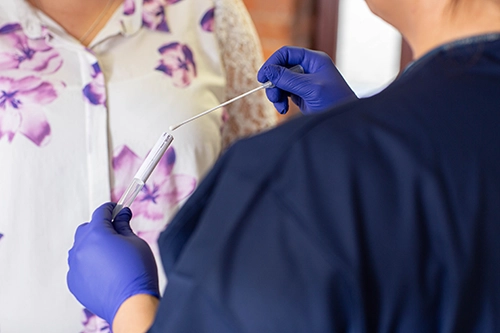
The collections process – what you need to know
By Adele French, Sample Collector Trainer
A Lextox sample collection is a critical step in ensuring accurate drug and alcohol testing. Our sample collectors are trained to a high standard and have a wealth of experience in collecting samples and adhering to chain of custody requirements, whilst being efficient and respectful. Understanding what to expect can help ease any concerns an individual may have prior to a drug and alcohol test. Here is a brief overview of the process, what the donor can expect on the day of testing and the types of tests that may be required.
Prior to collection
Safety is paramount for our collectors, after confirming their ID, they will ask health and safety questions to ensure the sample collection runs smoothly and the environment is suitable. This may be via a quick phone call before they attend, or sometimes at the door before they enter. The sample collector will also have an identification process they need to follow; this involves the donor showing photographic ID, such as a passport or driver’s license, and having a photograph taken.
Next, the sample collector will inform the donor of the testing requirements, including the type of sample required, this could include hair, blood, nails, or a buccal cheek swab for DNA. The sample collector will ensure the donor is fully aware of how much hair needs to be collected for a hair strand test – a common misconception is that a single strand of hair will be taken. However, for a hair drug and alcohol test, the collector will need to obtain at least two sections of hair from the donor, each section holding approximately 100 strands of hair.
Once the donor is fully informed and verbal consent has been obtained, our sample collector will professionally guide the donor through the sample collection process. We fully understand what an anxious time drug and alcohol testing can be for donors and pride ourselves on being sympathetic and non-judgmental.
Chain of custody
Prior to the physical taking of any sample, the collector will complete a chain of custody form with the donor. Written consent will be obtained from the donor and a set of questions will be asked regarding any medications taken, chemicals or treatments they’ve used on their hair and whether they have consumed substances or alcohol. This information is important as it is taken into consideration when interpreting the analysis results.
Hair drug and alcohol testing
When hair testing is needed, this usually involves cutting small samples of hair from the scalp, although other body areas can be used if necessary. The hair sample is cut as close to the scalp as possible and great care is taken by the sample collector to minimize the cosmetic impact to the donor.


Nail sample collection
When nail samples are needed, it is important to note the sample collector can only collect natural untreated nails. Additionally, the sample collector will also need to check if the donor has any medical conditions such as diabetes or peripheral arterial disease. The collection can still be conducted if these medical conditions are declared, however, we would only collect a fingernail sample as the improper cutting of toenails in donors with these conditions can be unsafe.
If the donor has nail polish on, they can remove it and wash their hands and the collection can go ahead. The sample collector will guide the donor through the nail cutting but the physical cutting will be undertaken by the donor.
Blood sample collection
When a blood sample is requested for alcohol testing, it is always helpful if the donor is well hydrated as this makes the blood draw more comfortable for the donor. Any concerns around having blood drawn can be highlighted with the collector attending the appointment; they have a wealth of experience in alleviating any nerves or worries that come hand in hand with a blood test.


DNA sample collection
For DNA samples, the sample collector will be required to rub two cotton bud swabs on the inside of the cheeks, near the back teeth, from the donor. This is a non-invasive procedure and we do recommend the donor doesn’t eat, drink, smoke or chew gum 30 mins prior to the sample collection.
After the physical sample has been collected, they are securely packaged and labelled in the presence of the donor to maintain the chain of custody. The samples are then posted to the laboratory for analysis.
To learn more about our collections process, get in touch here.
By Adele French
Sample Collector Trainer
Adele has worked at Lextox for six years, three as a sample collector and three as a sample collector trainer. Adele is also a trained phlebotomist of 16 years, having previously worked for the NHS for 10 years. She also has numerous other qualifications, including NVQ 2 in Health and Social Care, Protection of Vulnerable Adults and NHS trained on Violence and aggression/Manual Handling.

Published 28/11/2024. All information correct at time of publication.





